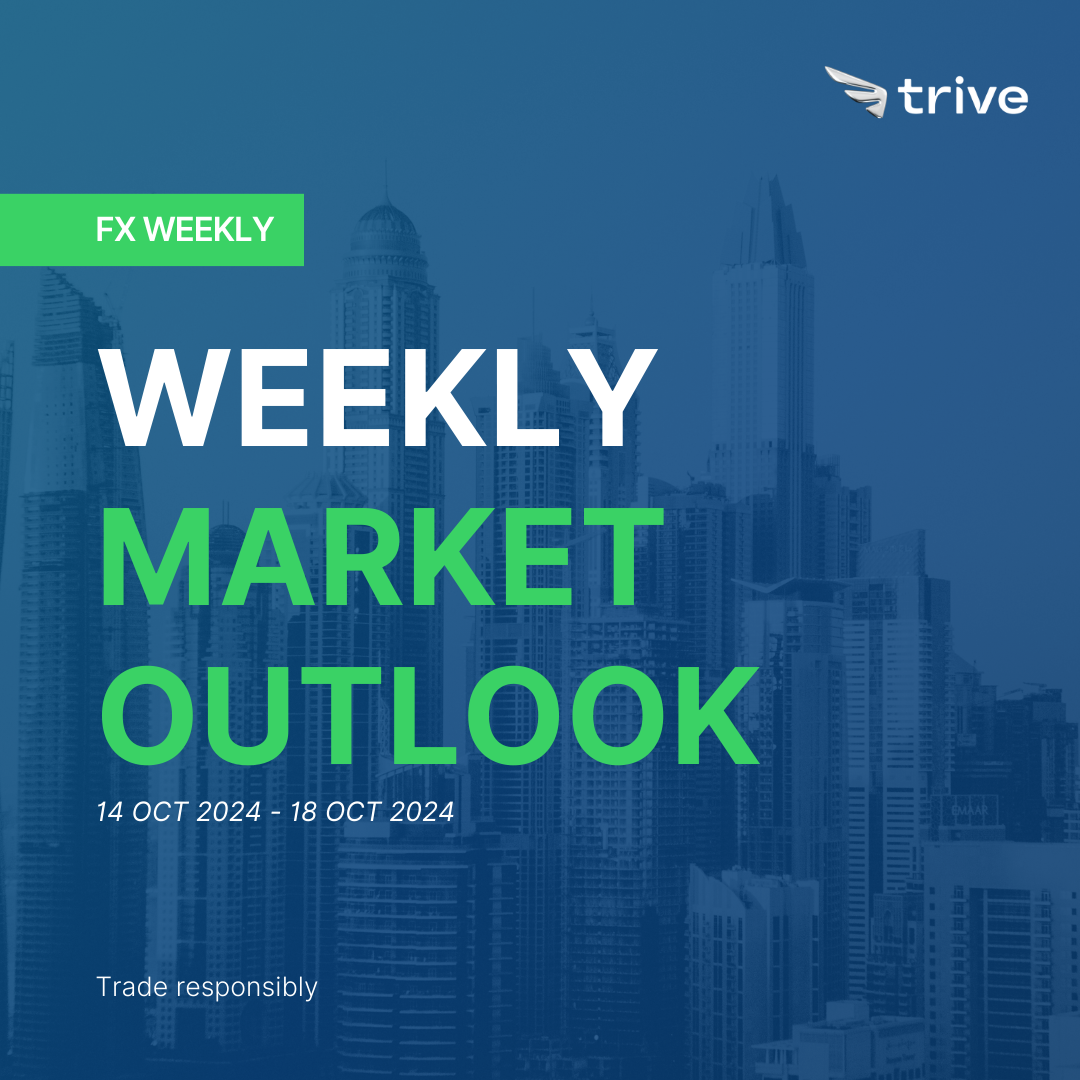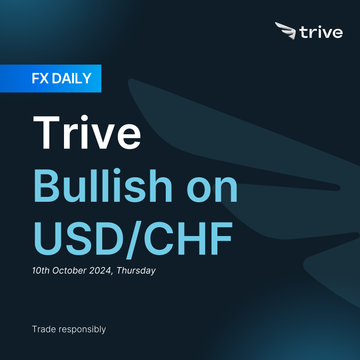FX Weekly: Trive’s Week Ahead Insights

The highlights include US Retail Sales, the ECB rate decision, inflation reports from Japan, China, New Zealand, United Kingdom and Canada, as well as Australian and UK employment numbers.
Chinese Trade Balance (Mon)
Trade balance for September is forecast to narrow to USD 89.80bln (prev. USD 91.02bln) with exports seen moderating to +6.0% Y/Y (prev. 8.7% Y/Y) but imports seen rising 0.9% Y/Y (prev. 0.5%). A couple of major developments last month could impact the data. Firstly, the data encapsulates the period in the run-up to the Golden Week Holiday (Oct 1-7th), while another factor is the trade frictions with the EU after the bloc imposed tariffs on Chinese-made EVs. Nonetheless, signs of weak domestic demand will be eyed, with Goldman Sachs flagging cautious spending during the Golden Week Holidays – “Low tourism spending per head and subdued services prices highlighted still weak domestic demand and continued consumption downgrading”, the desk said.
UK Jobs Report (Tue)
Expectations are for the unemployment rate to remain at the 4.1% mark in August. More pertinently for the BoE, ex-bonus average earnings is seen easing slightly to 5.0% from 5.1%. As a reminder, the prior release saw a downtick in the unemployment rate to 4.1% from 4.2%, employment change jumped to 265k (strongest 3M print since May 2022) from 97k, whilst headline earnings growth pulled back to 4.0% from 4.6%. For the upcoming report, Pantheon Macroeconomics notes that “September business surveys suggest a slowdown in output and hiring because of uncertainty about potential tax hikes in the October 30 Budget”. As such, the consultancy looks for PAYE payrolls to be unchanged on a M/M basis. From a pay perspective, PM notes that it places more weight on the BoE’s DMP report and Indeed wage tracker which have pointed to “stubbornly strong gains”.
Accordingly, the desk suggests “AWE is due for a strong rebound in August, after seemingly exaggerating the slowdown in pay growth over the past few months”. From a policy perspective, indicators heading in are for a rebound in the wage metrics which if realized would factor in favor of the hawkish contingent of the MPC who think the pace of normalization needs to be gradual. However, newswire consensus has stated looking for a slight moderation in wages which speaks to the dovish-contingent and provide evidence in support of Governor Bailey’s inflation-conditional guidance that they could be a bit more aggressive on easing.
Canada CPI (Tue)
Towards the end of September, Bank of Canada Governor Macklem said that officials are pleased to see inflation back at 2%, and policy now had to ‘stick the landing’. He said that with the continued progress seen on inflation, it was reasonable to expect further reductions in its policy rate, but the timing and pace will be determined by incoming data and policymakers’ assessments of what those data mean for future inflation. That said, Macklem still wants to see core inflation ease from current levels a little above 2%. Macklem had suggested that larger cuts are possible if the economy and CPI is weaker, so a soft CPI could perhaps bolster calls for a 50bp rate cut. Money markets were pricing in a near coin flip for 50 or 25 bps before the latest labour market report, however a very strong report saw 50bp rate cut bets unwind. Markets currently price in 34bps of easing, which implies a 36% probability of a 50bps rate cut.
New Zealand CPI (Tue)
CPI Y/Y is expected to have cooled 2.3% in Q3 Y/Y (prev. 3.3%) – in line with the RBNZ forecast from its August while the Q/Q metric is seen hotter at 0.7% (prev. 0.4%). Westpac notes that this quarter's inflation has been driven by large increases in local council rates, insurance premiums, and food prices, while weaker fuel prices and cheaper imported goods have helped to offset these rises. Westpac's forecast is slightly lower, at 2.2% annually and 0.7% quarterly - slightly below the RBNZ’s August Monetary Policy Statement forecasts of 2.3% Y/Y and 0.8% Q/Q, reflecting the fall in oil prices during the period.
UK Inflation (Wed)
Expectations are for the headline Y/Y to ease to 1.9% from 2.2% with the core pace also seen moderating though by a lesser extent to 3.5% from 3.6%. As a reminder, the prior release saw headline Y/Y CPI hold steady at 2.2%, core rise to 3.6% from 3.3% and the all-important services metric jump to 5.6% from 5.2% on account of unfavourable base effects and certain volatile sectors. For the upcoming report, the expected decline to 1.9% for the headline takes it back below the 2.0% target mark (after being above for two consecutive readings), though the BoE’s MPR forecast is for a 2.1% reading. Investec believes that the reading will come in below the BoE’s target and print at 1.7%, weighed on by declines in fuel prices for the month; though, recent price action in the energy space and ongoing geopolitical tensions/uncertainty means it is hard to say with conviction if this will be sustained or not.
From a policy perspective, this will be the final inflation report before the November policy announcement and MPR. On which, markets assign a circa 80% chance of a 25bps cut and therefore there is still some room for a dovish repricing. However, a hot release would provide ammo to the more cautious voices on the MPC and could set markets up for another split vote next month. As a reminder, at the start of the month BoE’s Bailey said they could possibly be a “bit more aggressive” in cutting rates, provided that inflation news continues to be good.
ECB Announcement (Thu)
Expectations are for the ECB to lower the deposit rate by 25bps from 3.5% to 3.25%, according to 68/75 surveyed by Reuters. Markets price such an outcome at 98%. In the wake of the September meeting, markets assigned just a 28% chance of an October rate cut and were of the view that the ECB would opt to lower rates at meetings that are accompanied by macro projections, whilst pausing at those that do not contain them (as a reminder, ECB cut in June, paused in July and cut in September). Furthermore, source reporting via Reuters stated that an October rate cut was unlikely as a move before December would require “exceptional negative growth surprises”. Fast forward to now and the playbook put forward by the ECB and absorbed by markets has been disregarded. The first wave of repricing for October was driven by the September PMI metrics which saw the EZ-wide manufacturing slip further into contractionary territory, services decline, dragging the composite into contractionary territory; its largest decline in 15 months.
Thereafter, inflation metrics for September added to the dovishness with headline HICP slipping below target to 1.8% from 2.2%, albeit super-core inflation only slipped to 2.7% from 2.8% and services inflation stands at a still-lofty 4%. As such, the market raced to price in an October rate cut. ECB speak has largely endorsed such a move with even some of the hawks on the GC open to such a move. That being said, from an alternative viewpoint, ING suggests that a rate cut is not a done deal. The desk cites the fact that soft inflation and growth outturns were already baked into the ECB’s forecasts, whilst comments from Germany’s Schnabel stated that, whilst the bank cannot ignore headwinds to growth, it cannot do much to solve structural weaknesses. Looking beyond October, a further 25bps cut is near-enough fully priced in for December with four further cuts expected in 2025.
Australian Jobs Report (Thu)
There are currently no market forecasts for the data, which last month saw Employment Change at 47.5k, Unemployment Rate at 4.2%, and Participation Rate at 67.1%. The Australian Employment Change topped forecasts at the time but was solely fuelled by Part-Time jobs. Westpac expects Employment Change in September to rise by 40k, below the 47.5k in August, though still above trend. The participation rate and unemployment rate are both forecast by the bank to remain unchanged at 67.1% and 4.2%, respectively. August's increase in employment was driven solely by part-time jobs, and Westpac suggests a continued tight but gradually balancing labour market as labour supply rises.
US Retail Sales (Thu)
US Retail Sales are expected to rise 0.3% M/M in September, accelerating from the 0.1% in August. Meanwhile, Core Retail Sales are expected to rise by 0.1%, maintaining the 0.1% pace seen in August. Bank of America’s monthly consumer checkpoint data points towards “modest forward momentum”; the bank’s aggregated credit and debit card spending per household was -0.9% Y/Y in September (prev. +0.9% Y/Y); seasonally adjusted spending was up +0.6% M/M. BofA writes “homeowners currently have a historically large share of equity in their homes, providing potential upside to spending if they tap this through a home equity line of credit, but home equity is not evenly distributed and a significant share of HELOC borrowing appears on our estimates associated with debt consolidation, so the impact on spending should not be exaggerated.” It adds that durable goods spending has been “robust,” but it finds that the share of higher-value durable transactions in its internal data has declined, with a corresponding rise in some services categories. “This suggests consumers may be prioritising value categories and experiences over big-ticket purchases.” Ahead, as we approach the holiday season, Adobe expects US online sales to hit USD 240.8bln in November and December combined (+8.4% y/Y). Shopping on mobile devices is expected to hit a new milestone, contributing a record USD 128.1bln (+12.8% y/Y); that would represent a 53.2% share of online spend this season (versus desktop shopping). Meanwhile, “Cyber Week” (the 5-day period including Thanksgiving, Black Friday and Cyber Monday) is expected to drive USD 40.6bln in online spend (+7.0% y/Y), representing 16.9% of the overall holiday season. Adobe expects Cyber Monday will remain the season’s and year’s biggest shopping day, driving a record USD 13.2bln in spend (+6.1% y/Y); Black Friday is expected at USD 10.8bln (+9.9% Y/Y), and Thanksgiving Day USD 6.1bln (+8.7% Y/Y), outpacing Cyber Monday in annual growth as consumers embrace earlier deals promoted by US retailers. Adobe says strong discounts of up to 30% are expected to encourage shoppers to “trade up” in categories like electronics and appliances, leading to over USD 2bln in additional spending this holiday season.
Japanese CPI (Fri)
Core CPI Y/Y is expected to cool to 2.3% in September from 2.8% in August. Tokyo's Core CPI, often used as a proxy for nationwide inflation, rose 2.0% Y/Y in September, matching the BoJ’s 2% target and market expectations, but down from 2.4% in August due to the resumption of government utility subsidies. A separate index excluding fresh food and fuel costs increased 1.6%, unchanged from August. Analysts will focus on whether service price hikes accelerate in October, with companies adjusting for higher labour costs amid rising wages. Despite BoJ Governor Ueda's recent cautious rhetoric, desks suggest economic fundamentals, including steady wage growth and resilient domestic spending, are laying the groundwork for possible tightening in December or January.
Chinese GDP (Fri)
Q3 GDP Y/Y is forecast to cool slightly to 4.6% from 4.7% in Q2. Goldman Sachs and Citigroup have both recently revised their full-year 2024 growth projections down to 4.7%, citing weaker-than-expected industrial output and retail sales in August. China's industrial output slowed to 4.5% Y/Y in August, down from 5.1% in July, while retail sales growth also decelerated to 2.1% from 2.7%. Analysts are closely watching whether the recent stimulus measures from China's PBoC, introduced in late September, will have any tangible effect on economic activity in Q4. However, the subdued fiscal announcement following the monetary stimulus leaves uncertainty around the timing and effectiveness of the policy passthrough. The risk of missing the government's full-year target of "around 5%" growth has increased, amplifying calls for additional demand-side measures to bolster the recovery.
UK Retail Sales (Fri)
Expectations are for a M/M reading of 0.0%, sharply down from the 1.0% prior and with a forecast range which bottoms out at -0.4%. A reading which is expected to be an unwinding of recent strength, which was driven by real-wage gains for households, and as consumers await a potentially significant fiscal update at the end of October. In terms of recent retail indicators, BRC Retail Sales for September Y/Y rose to 1.7% from 0.8% with the accompanying report noting “retail sales saw the strongest growth in six months as non-food performed better than expected… ongoing concerns of consumers about the financial outlook kept demand low for big ticket items such as furniture and white goods”. Elsewhere, Barclaycard said UK September consumer spending rose 1.2% Y/Y vs. prev. 1.0% growth in August and it cited a boost from discretionary spending but noted that essential spending fell 1.7% which was the steepest drop since April 2020. From a policy perspective, the release will likely do little to shape expectations for BoE easing with the MPC more focused on services inflation and real wage growth.
Disclaimer
This material is provided for informational purposes only and does not constitute financial, investment, or other advice. The opinions expressed in this material are those of the author and do not necessarily reflect the views of Trive International. No opinion contained in this material constitutes a recommendation by Trive International or its author regarding any particular investment, transaction, or investment strategy. This material should not be relied upon in making any investment decision.
The information provided does not consider the individual investment objectives, financial situation, or needs of any specific investor. Investors should seek independent financial advice tailored to their individual circumstances before making any investment decisions. Trive International shall not be liable for any loss, damage, or injury arising directly or indirectly from the use of this information or from any action or decision taken as a result of using this material.
Trive International may or may not have a financial interest in the companies or securities mentioned. The value of investments may fluctuate, and investors may not get back the amount they originally invested. Past performance is not indicative of future results.
For more information about Trive International, please visit http://trive.com/int
Additional Information
Investing involves risk, including the potential loss of principal. Diversification and asset allocation strategies do not ensure a profit or guarantee against loss. The content in this material is subject to change without notice and may become outdated or inaccurate over time. Trive International does not undertake any obligation to update the information in this material.
By accessing this material, you acknowledge and agree to the terms of this disclaimer. If you do not agree with these terms, please refrain from using this information.
No comments
Home
Trive
TriveHub





0 comments